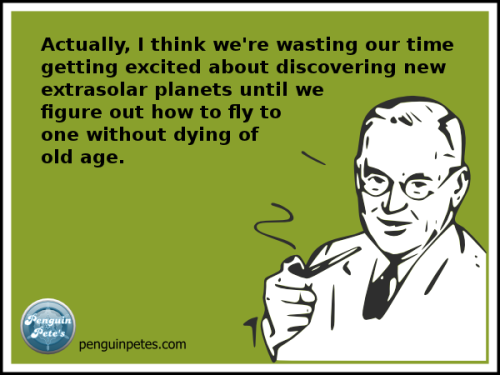Consider the following...
This is Gliese 581, a red dwarf star about 22 light-years from Earth in the direction of the Libra constellation. It's attracted huge attention in the scientific community the past few years, due to harboring - so far - six planets, three of which have a very good shot at having Earth-like conditions suitable for life. These three planets, c, d, and g, make up three out of the top five habitable planets given in this list. Variously, c, d, and g all make good candidates for either supporting Earth-class life already, or being a suitable place for the human race to colonize.
Now, you might be saying, "Great, 22 light-years away you say? What good is that without the Starship Enterprise?" Yes, I know. I've made similar snarky observations myself...
What if I told you that way back in 1955, an idea was proposed at the famous Los Alamos Laboratories whereby, using already-existing technology, we could have a man-made vehicle bridge a distance of 22 light-years in about 44 years? In fact the idea was suggested by Stanislaw Ulam in 1947, and further collaboration came from Freeman Dyson.
The project was Project Orion, which has now been shut down. A money quote from this section:
"A nuclear pulse drive starship powered by matter-antimatter pulse units would be theoretically capable of obtaining a velocity between 50% to 80% of the speed of light."
And - strictly in the abstract - a vehicle busting 0.5c could travel 22 light-years in 44 years. However, you do have to consider that this isn't necessarily the launch speed of the vehicle; it has to thrust for a long, long time to build up that speed. You also want to think about whether you need to stop at the end. For a fly-by or crash-into mission - which are what our first missions to the moon were - no worries there.
You might also ask "Wait, I thought antimatter was strictly science fiction." Well, no, it isn't. We've produced antimatter! Positrons were created in 2008 at the Lawrence Livermore National Laboratory, for one. CERN produced antihydrogen way back in 1995, for another. For that matter, you can get one positron every 75 minutes from a plain old banana. In 2011, CERN was reducing the problem to one of keeping antihydrogen stable - so far for 16 minutes:
But wait a minute - This hardy makes for a sustainable rocket fuel source, you say. Yes, quite true. But the general principle, that of using actual detonations of matter behind a ship to propel it forward as opposed to just chemical rockets, has many applications.
One of the problems of antimatter is that it's extremely expensive to produce, and even harder to keep around. But perhaps with more study, we could get it down to "canned antimatter" you could grab off a shelf and go.
Getting back to Project Orion, its main thrust was investigating nuclear pulse propulsion. Exactly what it sounds like on the tin, you fire off nuclear explosions at the rear of the vessel, and use this to attain as much as one-tenth light speed (0.1c.). This still closes a distance of 22 light-years in 220 years. Once again, fudge in acceleration / deceleration times, and you'd still get there in 400 years, or even less time if all you want to do is take a few pictures and readings from closer-by and transmit them by signal back to Earth.
Since Orion, other projects have sprung up based on its inspiration, some of them still active inquiries:
- Project Valkyrie - Proposed theoretical spacecraft which could use antimatter fusion to reach .92c. Over nine-tenths of light speed.
- Project Longshot - Started and stopped in the late 1980s by NASA, this would have been a rather conservative probe to Alpha Centauri B that could have gotten close-up data back to us by about the year 2195, using nuclear pulse propulsion at 0.43c.
- Project Daedalus - A 1970s study conducted by the British Interplanetary Society to inquire as to whether an unmanned vehicle could use then-current technology to reach another star within one human lifespan. The fastest they could then come up with was a fusion rocket to Barnard's Star in 50 years, also about 0.1c.
- Project Prometheus - Done in 2003-2005, this was another NASA study investigating the potential behind nuclear-powered systems, bouncing around ideas such as nuclear-powered ion thrusters and the like.
All of these studies indicate that even without faster-than-light travel, at least scientific probes and telescope missions could bridge the cosmos in reasonable time - for interstellar distances. And there's many more past projects and studies where those came from. We need not be intimidated by the light-year for very much longer!


